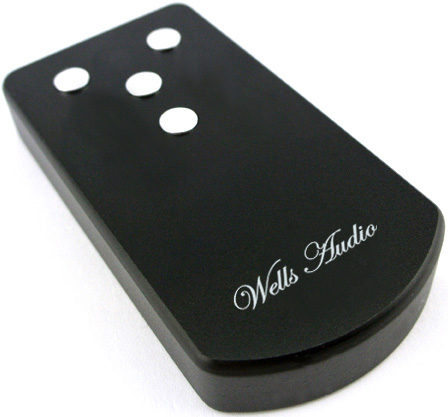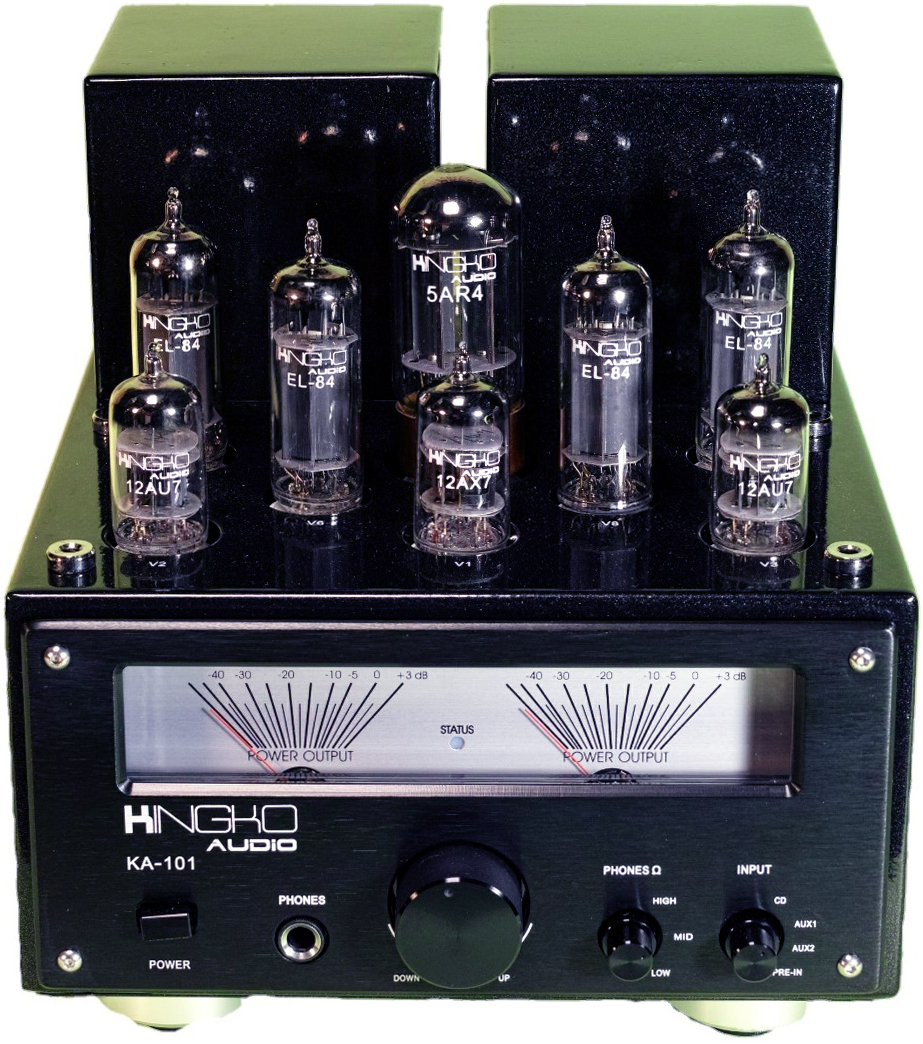It’s been a while since tube/valve gear made any extended appearance in any of my homes. Nothing against the gear, but what with graduation and traveling and not settling down it just wasn’t practical. This is not to say that in my time I did not possess tube/valve gear from Audio Research and Conrad-Johnson, but those times were indeed fleeting, and with the renewed interest in tube/valve gear by the public I thought it high time, now that I’m more situated,to start taking a look at what’s new.
Having attended and covered more than a few Hi-Fi shows, I would always make my way to the Rogers High Fidelity exhibit room where their gear was coupled with Burwell & Sons horn speakers. There was something about the sound. As I got to know Roger Gibboni, Rogers’ President & chief designer, and Rob Pleyer, its Director of Sales, I became more and more comfortable with them, to the point that I could ask to audition their idea of a 21st century integrated amplifier, the 65V-1, a class A, singled ended, lower power design. The unit they sent came with EL34s, but purchasers can specify their preference for KT88’s if they so desire.
The Rogers High Fidelity 65V-1 integrated amplifier ($4,000) comes with a lifetime warranty and has the look and tangible feel of a traditionally designed unit.With its Teflon coated military specification wire and military specification components, not to mention its point to point wiring, one could rightly think the 65V-1 was designed to be combat ready, and that would not be too far off target. But don’t let all that military precision fool you, there’s a wrinkle here sure to please the folks in Cupertino. Rogers has designed an iPad [iOS] remote control app relying upon Bluetooth connectivity to do the following:
▪ Display the power out on a virtual VU meter
▪ Enable users to switch between triode/ultra-linear output (more on that to follow)
▪ Enable users to switch between line level inputs
It took a while for me to become accustomed to using an iPad to remotely control the 65V-1 and, mind you, I’ve always been an early tech adopter. Still, being as it was the first time encountering such, I had to remember that when grabbing for the remote that, given it’s an iPad, it does indeed multitask, and for that reason just might be off somewhere in another room. Note: In my communications with both Roger and Rob of Rogers, I pleaded with them to think about making the iOS app available for the iPhone as well. And from what I understand some new designs will be iPhone compatible, and I’m hoping the 65V-1 will be retrofitted.
The remote-control app and its virtual VU meter are critical. The meter is calculated in watts from 0 to 25 and it samples both channels’ power output and in turn displays continuous average power. Simply put, Rogers would like its customers to note when they start to hear clipping, and then turn the volume down to just about 20% below this level. For the uninitiated this takes practice. It is not an insurmountable task, and while the iPad remote control is not absolutely necessary, it is fun, but the purplish LCD-like display can be hard to read at times.
The 65V-1 is a kit that an engineer could just … its look, its feel, the mechanical switches really brought me back. It is physically imposing at 17” W x 7.5”H and 12” D, but at 24lbs, the 65V-1 is lighter than I would have thought. As stated earlier, the model sent to me came with Mullard EL34 tubes/valves, I could have requested KT88s as well, but I let Rogers decide. To be fair, this started out as Rogers being rather friendly to me and sending me the unit to audition and not review, so I can get a better read of Rogers as a company, its design philosophy and workmanship. Over time, I became entranced to the point where I just wanted to share my experiences with my readers.
You will notice in the picture above that one of the toggles is expressly for switching between headphones and speakers. It’s a nice feature to have as I made great use of the headphone jack when I transported the 65V-1 from my primary listening area into my office, where I work more often wearing headphones. This is an oddity, as I cannot stand wearing headphones in my normal listening configuration, but when sitting near field, I’m okay with it. Hmm. This will require some self-exploration. Note: While Rogers does supply a headphone jack, one is not likely to purchase a 65V-1 solely for that purpose. It did an admirable job of powering my Audioquest Nighthawks and Meze Classic & Neo 99 and, if anything, I would say this functionality is a very welcome feature and for some could be a deciding factor in comparison with similar tube/valve integrated amplifiers lacking such.
Connecting the 65V-1 is pretty much straightforward. About the only thing I could mention is that upon powering up users should note that there is a red light on the power toggle. This indicates the unit is powered on. The digital display will take about 60 seconds while the filament slow-start circuit starts up. This slow start circuit is designed to significantly increase the tube lifetimes. Yes, there is a Bluetooth antenna that comes with, and yes, it is easy to screw on and install. The iPad remote control will not work without that being attached.
Even though it’s been a while, I still remember that tube/valve gear doesn’t just need but demands high efficiency/sensitive speakers. To that end I was prepared. I could have connected some less than efficient speakers, but to what end? I knew what that would mean, and I was not going to put either myself or you through it for that matter. I assembled a series of speakers with which to listen to the 65V-1, all of which are rated at 90 dB or higher:
• Audio Note AX-2
• Blumenstein Audio Marlin
• Blumenstein Audio Orca
• Klipsch Quartet
• Tekton Design Mini Lore Monitor
These speakers range from 90 dB to 97 dB in rated sensitivity by their respective manufacturers. The 65V-1 played nicely with all of them. The AX-2 being rated at 90 dB gave me some initial concern, but that’s when more fun began as I started switching between Triode and Ultra-linear output modes. Long story short, as I wrestled with the idea of providing a history of and detailed definition/description/differentiation of the modes, the number of pages and the sheer boredom started setting in. Again, I am not going to put you, my readers, through that. What I will say is that in ultra-linear mode the 65V-1 appears to pack more punch, although it comes with a loss of detail in comparison to triode mode, in which less sensitive speakers fare worse and the higher efficiency speakers let me relax and soak in the finer detail and the nuances of the recordings in my listening sessions.
Here’s a breakdown of how each of the speakers fared with respect to output modes: the Audio Note AX-2 and Blumenstein Audio Marlin speakers sounded fuller and more authoritative in Ultra-linear mode. The Blumenstein Audio Orca, Tekton Design Mini Lore Monitor and Klipsch Quartets took just about everything in stride and flourished in Triode mode.
What I listen to is not important, and should not be. This is why I continually omit my reference recordings in my writings. They are mine and not yours. Why am I highlighting this at this juncture? Because it speaks to ultra-linear vs. triode mode. At the end of the day the decision is subjective. Yes, there will be compromises and trade-offs but those are decisions only you can make and hear for yourself. I can only guide you so far. What I can share with you is my Facebook Project: New Album Releases – curation and listing of recordings released in calendar year 2018 – and apart from my reference recordings, I listen to a great deal of this music while auditioning gear, so maybe you’ll find something here: https://www.facebook.com/groups/newalbumreleases
My primary listening room is large (24’ x 20’) and I must say that with the appropriate speakers the Rogers 65V-1 filled the room with sound. The ephemeral glow of the tubes at night was an added plus. They transported me back in time…fade to a Montgomery Burns moment. The 65V-1 felt at home in my office as well, I just had to clear up some space, which forced me to de-clutter as its footprint is noticeably larger than either my Bel Canto Design s300 or the truly diminutive PS Audio Sprout 100. Well built, professionally designed and taking a bite out of 21st century technology, the 65V-1 could very well be the tube/valve integrated amplifier for this generation. There’s more going on under the hood.
Copy editor: Dan Rubin
Manufacturer’s Comment:
Rogers High Fidelity would like to personally thank both David Blumenstein and Dagogo for reviewing our model 65V-1 and for all of the insight on it’s merits for the end user.
Thank you and best regards,
Roger Gibboni – President
Rogers High Fidelity
The post Rogers High Fidelity 65V-1 tube integrated amplifier Review appeared first on Dagogo.

















































 and AAC Bluetooth streaming and even a Moving Magnet Phono stage for vinyl fans. The A14MKII is certified
and AAC Bluetooth streaming and even a Moving Magnet Phono stage for vinyl fans. The A14MKII is certified 


























